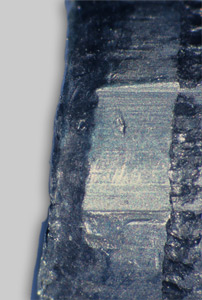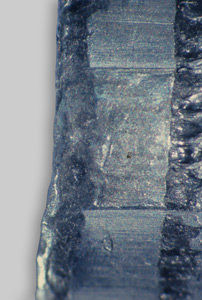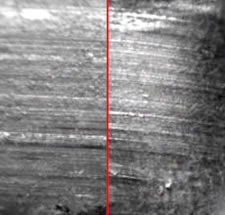Home | Glossary | Resources | Help | Contact Us | Course Map
Archival Notice
This is an archive page that is no longer being updated. It may contain outdated information and links may no longer function as originally intended.
Identification
Firearms identification is simply a firearms-related specialized subset of toolmark identification. A tool is defined as the harder of two objects; when the harder object is brought into contact with the softer object, the softer object will be marked.
This is what happens when a fired bullet (typically made of some softer metal such as a lead or a copper-jacketed bullet) engages the rifling in the interior of a barrel. Rifling is found in a machined steel surface bearing unique microscopic characteristics as a result of the process of manufacture. When the bullets are fired, the marks are transferred to the surfaces of the fired bullets and appear as parallel striated marks.
AFTE defines striations as contour variations (generally microscopic) on the surface of an object caused by a combination of force and motion, where the motion is approximately parallel to the plane being marked. The toolmarks on fired bullets reflect both class and individual characteristics in their general rifling characteristics and identifiable striae. Subclass characteristics may also be present on the fired bullet surface.
Physical Characteristics
The three categories of marks found on a fired bullet surface are typically class, subclass, and individual characteristics as defined below:
- Class characteristics Measurable features of a specimen that indicate a restricted group source. They result from design factors and are therefore determined prior to manufacture. In the context of this module, general rifling characteristics of the barrel of a firearm are the class characteristics of interest.
- Individual characteristics Marks produced by the random imperfections or irregularities of tool surfaces. These random imperfections or irregularities are produced incidental to manufacture and/or are caused by use, corrosion, or damage. They are unique to a particular tool and distinguish it from all other tools. In the context of this module, the tool is the interior of the barrel of a rifled firearm.
Note: Accidental characteristics is a term formerly used to mean individual characteristics. - Subclass characteristics Discernable surface features of an object that are more restrictive than class characteristics in that they are
- produced incidental to manufacture,
- significant because they relate to a smaller group source, that is, a subset of the class to which they belong,
- identifiable within a time frame since manufacturing processes change over time.
- In the context of this module, subclass characteristics relate to limited resemblances that could appear in consecutively manufactured barrels that are rifled using the same tool. These subclass characteristics could persist for a period of time even though the overall individual characteristics of the tool (rifling, broach, etc.) change with each barrel produced. Subclass characteristics should not be confused with individual characteristics. Subclass characteristics typically appear on the groove impressions rather than the land impressions of fired bullets. They may be misinterpreted, especially in cases with very limited microscopic marks of value, or in instances in which no firearm is submitted.
Additional Online Courses
- What Every First Responding Officer Should Know About DNA Evidence
- Collecting DNA Evidence at Property Crime Scenes
- DNA – A Prosecutor’s Practice Notebook
- Crime Scene and DNA Basics
- Laboratory Safety Programs
- DNA Amplification
- Population Genetics and Statistics
- Non-STR DNA Markers: SNPs, Y-STRs, LCN and mtDNA
- Firearms Examiner Training
- Forensic DNA Education for Law Enforcement Decisionmakers
- What Every Investigator and Evidence Technician Should Know About DNA Evidence
- Principles of Forensic DNA for Officers of the Court
- Law 101: Legal Guide for the Forensic Expert
- Laboratory Orientation and Testing of Body Fluids and Tissues
- DNA Extraction and Quantitation
- STR Data Analysis and Interpretation
- Communication Skills, Report Writing, and Courtroom Testimony
- Español for Law Enforcement
- Amplified DNA Product Separation for Forensic Analysts




